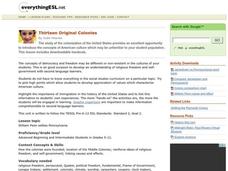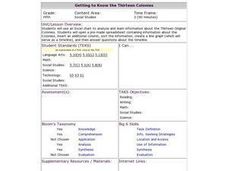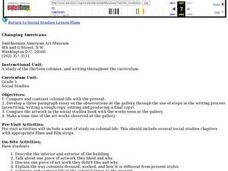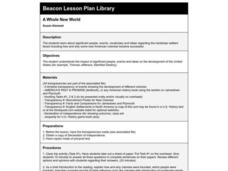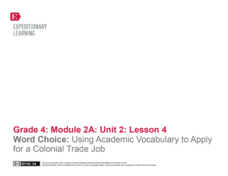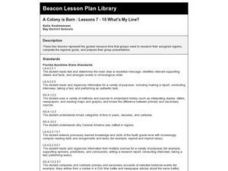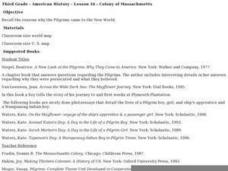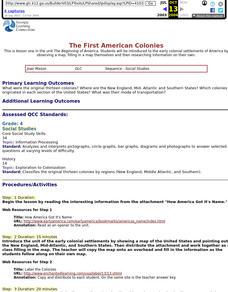Curated OER
Thirteen Original Colonies
An outstanding lesson on the Thirteen Original Colonies, and the settling of Pennsylvania by William Penn is here for your learners. Valuable discussion takes place regarding how the colonies were settled, and some excellent handouts are...
Curated OER
Colonial Vacation Planner
Looking for a good lesson on the Colonial Period for your upper-elementary class? Then, this lesson is for you! They use website designs, U.S. travel publications, and maps to plan a family vacation to states which were part of the...
Curated OER
British Colonization-Settling the Thirteen Colonies (1607-1733)
Students study the thirteen colonies: geography, economics, politics, and religious groups. They explore early colonial life, and create a travel brochure, travel guide of the 13 Colonies, and word search.
Curated OER
Getting to Know the Thirteen Colonies
Fifth graders analyze information about the thirteen colonies. Using the information, they can manipulate and identify a region in which the colony is located. As a class, they make generalizations about the various regions and time...
Curated OER
The Original 13 Colonies and 3 Regions
Seventh graders review the content of American History and focus upon the original thirteen colonies. They also study the geography of the region. It is recommended that students have other lessons delivered on the topic prior to this one.
Curated OER
Thirteen Original Colonies
Students use maps, the Internet, graphic organizers and discussion to explore the history of the Middle American Colonies. They consider how the colonies were founded and the ideas of religious freedom and self-government they embodied.
US Citizenship and Immigration Services
Thanksgiving 2—The Pilgrim Story and My Immigrant Story
The tradition of the First Thanksgiving is really a story of immigration. Connect the feelings and customs of the early Pilgrims to the experiences of the immigrants in your class with an introduction to the 13 colonies, the Mayflower,...
Curated OER
The 13 Colonies HyperStudio Presentation
Fifth graders research their colony, synthesize the data, and put their information in a HyperStudio Presentation. Finally, they need to do a self-evaluation of their work and work habits.
Curated OER
A Whole New World
Students examine a timeline of a sequence of events displaying how the colonies were founded. They analyze Jamestown and Plymouth recruitment posters, write journal entries, and play a Jeopardy game with questions about the colonies.
EngageNY
Word Choice: Using Academic Vocabulary to Apply for a Colonial Trade Job
Scholars reflect upon colonial jobs such as a blacksmith, cooper, shoemaker, etc. Together, the class writes a job application as a practice for working independently. Learners employ their experience in writing a job application for a...
Curated OER
A Colony is Born : Lesson 6 -To Leave or Not to Leave
Fifth graders connect reasons for coming to the New World with identity. The create identities and place them in one of three settled regions. They refer to prior study notes in their Colonial Notebooks to establish their identities.
Curated OER
A Colony is Born : Lessons 7 - 10 What's My Line?
Fifth graders research their assigned regions, complete regional guide and prepare presentations about the New World colonists. They refer to "Everyday LIfe: Colonial Times" as well as searching marked internet sites.
Curated OER
Colony Crops
Fifth graders determine which crops were grown in the 13 colonies depending on their climate and geography. They explore what crops are grown in the states created from the original colonies.
Stanford University
Declaration of Independence
Scholars work in pairs to decide whether leaders wrote the Declaration of Independence for the rich and powerful or for every man. To draw their conclusion, pairs read excerpts from two historians and complete a graphic organizer...
Curated OER
Migration and Immigration in the United States: Three Case Studies
Students examine the early migration of Native Americans, African Americans, and the British Colonists. They conduct Internet research, complete a timeline, label maps, compare/contrast the three groups' experiences, and write an essay.
Curated OER
The Mayflower Compact
Fourth graders explore the events leading up to the Mayflower Compact. In this government lesson, 4th graders have a teacher-led class discussion on the importance of government, then complete a worksheet on the topic.
Curated OER
Geographic Features of the East Coast
Fourth graders view a map of the thirteen colonies and discuss why the people who came from England built towns along the Atlantic coast. They read the directions on the worksheet and underline words in the question that ask them to do...
National First Ladies' Library
Colonial America: The Original 13
Middle schoolers work in small groups to research the initial history of two colonies and answering a list of questions. They then prepare a PowerPoint presentation or poster that includes all the findings of the questions and share...
Curated OER
Colony of Massachusetts
Third graders recall the reasons why the Pilgrims came to the New World. They ideology and compare and contrast the ideology of the Puritans and Roger iams. They study the colony of New York.
Curated OER
Rollin' on The River - the Hudson River!
Students examine how the Hudson River was important to the development of the United States. They examine the role of steamboats played in the development of the Hudson River Valley.
Curated OER
President's Day: George Washington
Students celebrate President's Day by studying George Washingtion, the US flag, and the American colonies. They sing, Yankee Doodle Dandy.
Curated OER
The Happy Progress of Our Affairs: George Washington and the U.S. Constitution
Students engage in a lesson which uses Washington's own words to illustrate the events leading to the establishment of our national government, and the crucial roles he played throughout that process.
Curated OER
The First American Colonies
Fourth graders are introduced to the early colonial settlements of America by observing a map, filling in a map themselves and then researching information on their own.
